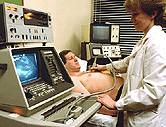
MONDAY, March 26 (HealthDay News) — Most people who go to the emergency room with chest pain aren’t having a heart attack, but it can take hours or days to make a definitive diagnosis.
However, a new study finds that a special kind of CT scan given in the emergency room seems to identify a heart attack faster than traditional methods, so patients can be sent home safely sooner.
“You can go to an emergency department with chest pain, be concerned it might be a heart attack — get a CT scan, like we do for everything else in the emergency department — and we can say it’s not your heart and you can go home, within a couple of hours,” said researcher Dr. Judd Hollander, clinical research director of the department of emergency medicine at the University of Pennsylvania, in Philadelphia.
“We can now answer the questions faster, and let people go home sooner,” he said.
Using the CT scan is faster, Hollander said, noting it can take 25 hours to get the results of blood tests that indicate whether a patient has had a heart attack.
“And an EKG only shows if you are having the big one,” Hollander added. “So, if it’s negative it doesn’t tell you if you are having a smaller heart attack, and two-thirds of heart attacks will have an EKG that’s not diagnostic.”
For every 100 patients who go to an ER with chest pain, only 10 or 15 have cardiac disease, Hollander said. “The other 90 percent end up with nothing serious,” he added.
In addition, ERs are busy and crowded, and this is a way to move patients out faster and increase the ability to see more patients sooner, he said.
The findings were to be presented Monday at the American College of Cardiology’s annual meeting in Chicago. They will also be published simultaneously in the New England Journal of Medicine.
For the study, Hollander’s team randomly assigned more than 1,300 patients with chest pain, but no previous history of heart disease or risk factors such as high blood pressure or diabetes, to CT scans or regular care.
The scans generate three-dimensional images of the heart and the blood vessels surrounding it, the researchers noted.
Among those with a normal scan, none died or had a heart attack within a month after being seen in the ER. In addition, more of these patients were sent home than those who received usual care — about 50 percent versus 23 percent, the researchers found.
Those who received scans spent less time in the hospital and had heart problems diagnosed faster.
Scans are also cost-effective, Hollander said. The tests, which are like a standard CT scan, cost about $1,500. Patients who have a normal scan can be sent home within a few hours. A patient who is admitted to the hospital can run up bills of more than $4,000 for stress tests and monitoring alone, the researchers noted.
Chest pain is one of the most common reasons people go to the emergency room in the United States, accounting for as many as 8 million visits each year, at a cost of several billion dollars, they noted.
Many patients with chest pain are suffering from anxiety, pneumonia or indigestion that can cause the same symptoms as a heart attack, the researchers explained. Yet, more than half of patients with chest pain are admitted to the hospital for observation or testing such as cardiac catheterization or a stress test.
Commenting on the study, Dr. Gregg Fonarow, director of the Ahmanson-UCLA Cardiomyopathy Center and co-director of the UCLA Preventative Cardiology Program, said that “there are 8 million men and women that present to emergency medical centers with chest pain each year.”
There has been great interest in developing strategies to more efficiently evaluate these patients and identify which ones can be safely discharged, he said.
The trial demonstrated that these scans may be useful to screen low- to moderate-risk patients, Fonarow said.
“However, further studies are needed to evaluate the cost-effectiveness of this strategy and how it compares to protocols using high-sensitivity troponin tests,” he added.
A troponin test measures the levels of one of two proteins, troponin T or troponin I, in blood, Fonarow explained. These proteins are released when the heart has been damaged, such as during a heart attack. However, this test is usually repeated over 12 to 16 hours, so the results do not come back as quickly as a CT scan.
More information
For more on heart attacks, visit the American Heart Association.

